coolant level SKODA ROOMSTER 2010 1.G Owner's Manual
[x] Cancel search | Manufacturer: SKODA, Model Year: 2010, Model line: ROOMSTER, Model: SKODA ROOMSTER 2010 1.GPages: 231, PDF Size: 12.91 MB
Page 17 of 231
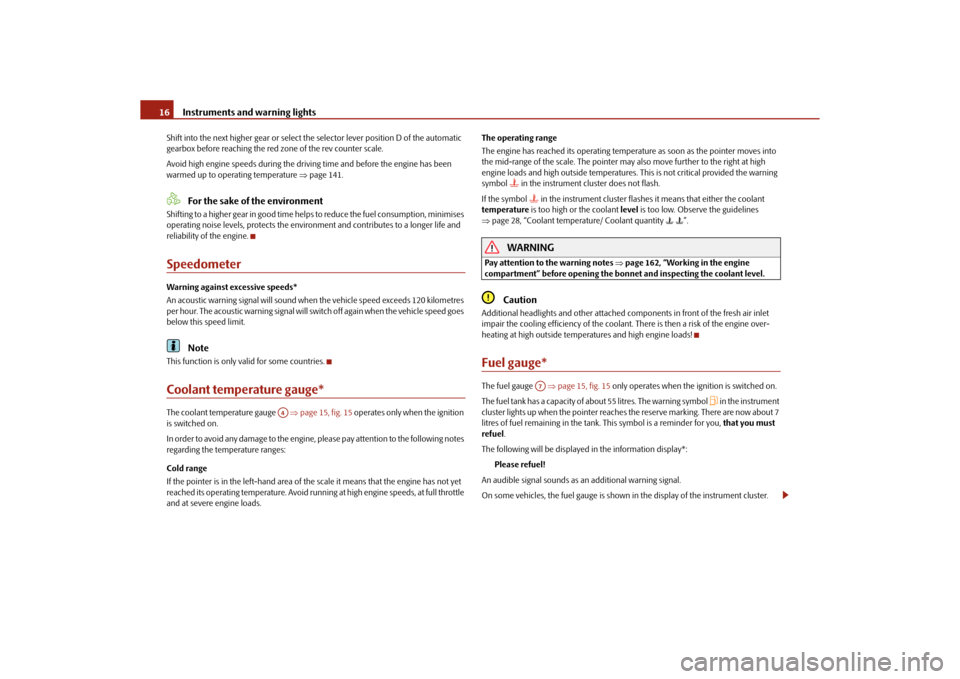
Instruments and warning lights
16
Shift into the next higher gear or select th e selector lever position D of the automatic
gearbox before reaching the red zone of the rev counter scale.
Avoid high engine speeds du ring the driving time and before the engine has been
warmed up to operating temperature page 141.
For the sake of the environment
Shif ting to a highe r g ear in g ood tim e hel p s to reduce the fuel consumption, minimises
operating noise levels, protects the environment and contributes to a longer life and
reliability of the engine.SpeedometerWarning against excessive speeds*
An acoustic warning signal will sound when the vehicle speed exceeds 120 kilometres
per hour. The acoustic warning signal will switch off again when the vehicle speed goes
below this speed limit.
Note
This function is only valid for some countries.Coolant temperature gauge*The coolant temperature gauge page 15, fig. 15 operates only when the ignition
is switched on.
In order to avoid any damage to the engine, please pay attention to the following notes
regarding the temperature ranges:
Cold range
If the pointer is in the left-hand area of the scale it means that the engine has not yet
reached its operating temperatur e. Avoid running at high engine speeds, at full throttle
and at severe engine loads. The operating range
The engine has reached its operating temperature as soon as the pointer moves into
the mid-range of the scale. The pointer may
also move further to the right at high
engine loads and high outside temperatures. This is not critical provided the warning
symbol
in the instrument cl uster does not flash.
If the symbol in the instrument cluster flashes it means that either the coolant
temperature is too high or the coolant level is too low. Observe the guidelines
page 28, “Coolant temperature/ Coolant quantity ”.
WARNING
Pay attention to the warning notes page 162, “Working in the engine
compartment” before opening the bonn et and inspecting the coolant level.
Caution
Additional headlights and other attached components in front of the fresh air inlet
impair the cooling efficiency of the coolant. There is then a risk of the engine over-
heating at high outside temper atures and high engine loads!Fuel gauge*The fuel gauge page 15, fig. 15 only operates when the ignition is switched on.
The fuel tank has a capacity of about 55 litres. The warning symbol
in the instrument
cluster lights up when the pointer reaches the reserve marking. There are now about 7
litres of fuel remaining in the tank. This symbol is a reminder for you, that you must
refuel .
The following will be displayed in the information display*: Please refuel!
An audible signal sounds as an additional warning signal.
On some vehicles, the fuel gauge is shown in the display of the instrument cluster.
A4
A7
s16g.4.book Page 16 Wednesda y, February 10, 2010 3:53 PM
Page 26 of 231
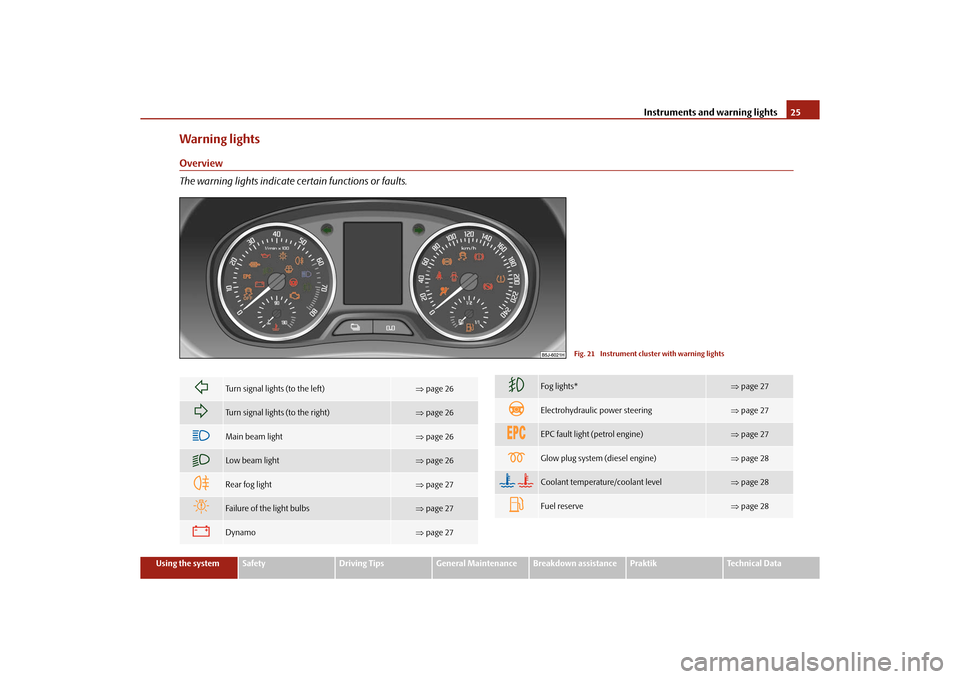
Instruments and warning lights25
Using the system
Safety
Driving Tips
General Maintenance
Breakdown assistance
Praktik
Technical Data
Warning lightsOverview
The warning lights indicate certain functions or faults.
Fig. 21 Instrument cluster with warning lights
Turn signal lights (to the left)
page 26
Turn signal lights (to the right)
page 26
Main beam light
page 26
Low beam light
page 26
Rear fog light
page 27
Failure of the light bulbs
page 27
Dynamo
page 27
Fog lights*
page 27
Electrohydraulic power steering
page 27
EPC fault light (petrol engine)
page 27
Glow plug system (diesel engine)
page 28
Coolant temperature/coolant level
page 28
Fuel reserve
page 28
s16g.4.book Page 25 Wednesda y, February 10, 2010 3:53 PM
Page 29 of 231
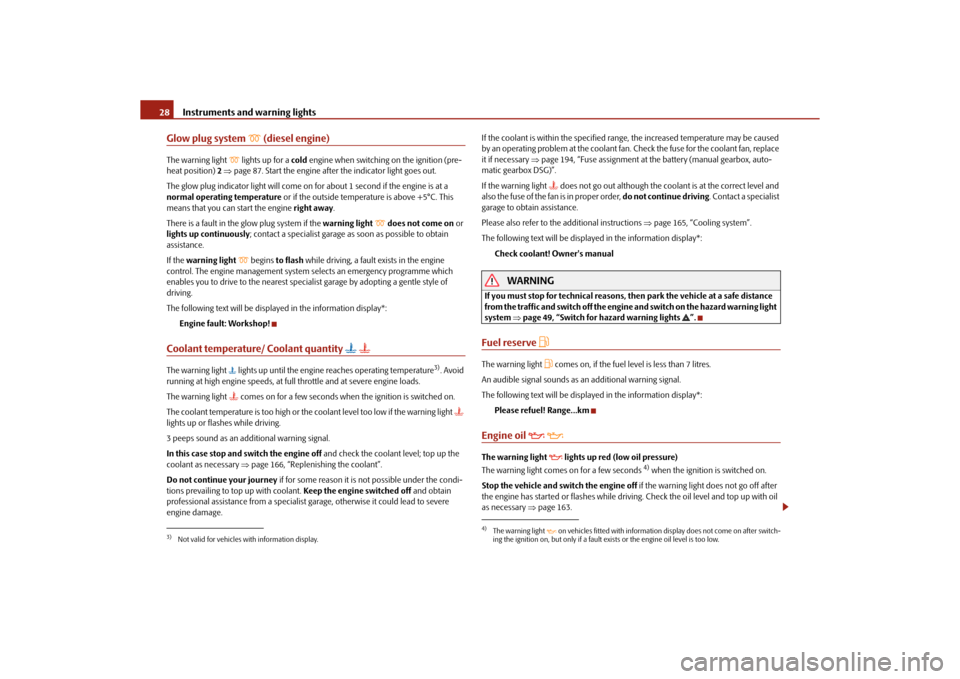
Instruments and warning lights
28
Glow plug system
(diesel engine)
The warning light
lights up for a cold engine when switching on the ignition (pre-
heat position) 2 page 87. Start the engine after the indicator light goes out.
The glow plug indicato r light will come on for about 1 second if the engine is at a
normal operating temperature or if the outside temperature is above +5°C. This
means that you can start the engine right away.
There is a fault in the glow plug system if the warning light
does not come on or
lights up continuously ; contact a specialist garage as soon as possible to obtain
assistance.
If the warning light
begins to flash while driving, a fault exists in the engine
control. The engine management system selects an emergency programme which
enables you to drive to the nearest specialist garage by adopting a gentle style of
driving.
The following text will be displayed in the information display*:
Engine fault: Workshop!
Coolant temperature/ Coolant quantity
The warning light lights up until the engine reaches operating temperature
3). Avoid
running at high engine speeds, at full throttle and at severe engine loads.
The warning light
comes on for a few seconds when the ignition is switched on.
The coolant temperature is too high or the coolant level too low if the warning light
lights up or flashes while driving.
3 peeps sound as an additional warning signal.
In this case stop and switch the engine off and check the coolant level; top up the
coolant as necessary page 166, “Replenishing the coolant”.
Do not continue your journey if for some reason it is not possible under the condi-
tions prevailing to top up with coolant. Keep the engine switched off and obtain
professional assistance from a specialist garage, otherwise it could lead to severe
engine damage. If the coolant is within the specified range, the increased temperature may be caused
by an operating problem at the coolant fan.
Check the fuse for the coolant fan, replace
it if necessary page 194, “Fuse assignment at th e battery (manual gearbox, auto-
matic gearbox DSG)”.
If the warning light
does not go out although the coolant is at the correct level and
also the fuse of the fan is in proper order, do not continue driving. Contact a specialist
garage to obtain assistance.
Please also refer to the additional instructions page 165, “Cooling system”.
The following text will be displayed in the information display*: Check coolant! Owner's manual
WARNING
If you must stop for technical reasons, then park the vehicle at a safe distance
from the traffic and switch off the engine and switch on the hazard warning light
system page 49, “Switch for hazard warning lights ”.Fuel reserve
The warning light
comes on, if the fuel leve l is less than 7 litres.
An audible signal sounds as an additional warning signal.
The following text will be displayed in the information display*: Please refuel! Range...km
Engine oil
The warning light
lights up red (low oil pressure)
The warning light comes on for a few seconds
4) when the ignition is switched on.
Stop the vehicle and switch the engine off if the warning light does not go off after
the engine has started or flashes while driving. Check the oil level and top up with oil
as necessary page 163.
3)Not valid for vehicles with information display.
4)The warning light on vehicles fitted with information display does not come on after switch-
ing the ignition on, but only if a fault exists or the engine oil level is too low.
s16g.4.book Page 28 Wednesda y, February 10, 2010 3:53 PM
Page 30 of 231
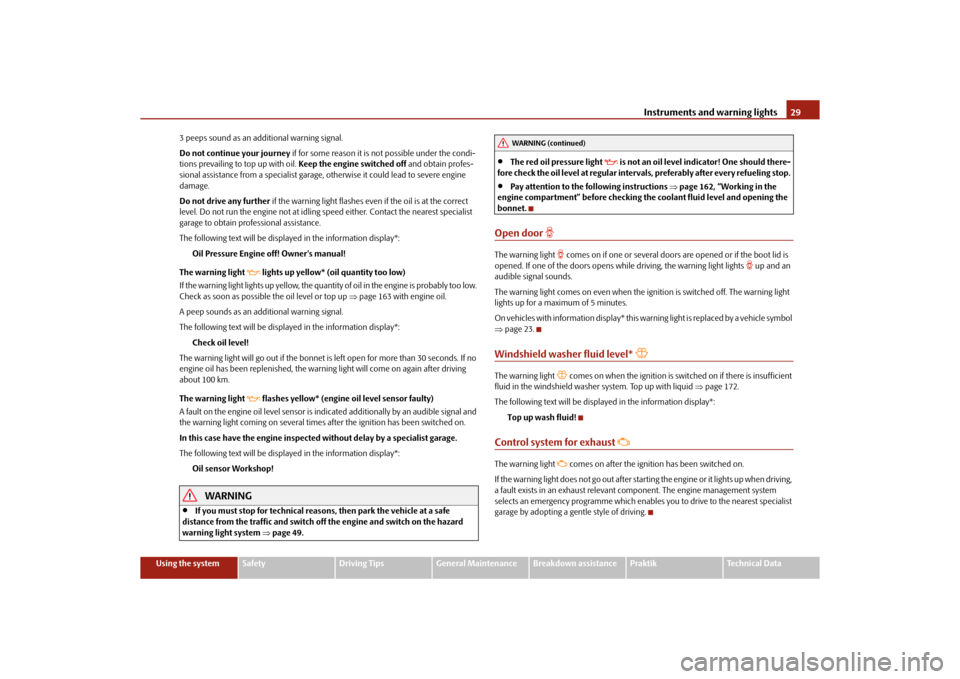
Instruments and warning lights29
Using the system
Safety
Driving Tips
General Maintenance
Breakdown assistance
Praktik
Technical Data
3 peeps sound as an additional warning signal.
Do not continue your journey
if for some reason it is not possible under the condi-
tions prevailing to top up with oil. Keep the engine switched off and obtain profes-
sional assistance from a specialist garage, otherwise it could lead to severe engine
damage.
Do not drive any further if the warning light flashes even if the oil is at the correct
level. Do not run the engine not at idling speed either. Contact the nearest specialist
garage to obtain professional assistance.
The following text will be displayed in the information display*:
Oil Pressure Engine off! Owner's manual!
The warning light
lights up yellow* (oil quantity too low)
If the warning light lights up yellow, the quantity of oil in the engine is probably too low.
Check as soon as possible the oil level or top up page 163 with engine oil.
A peep sounds as an additional warning signal.
The following text will be displayed in the information display*: Check oil level!
The warning light will go out if the bonnet is le ft open for more than 30 seconds. If no
engine oil has been replenished, the warning light will come on again after driving
about 100 km.
The warning light
flashes yellow* (engine oil level sensor faulty)
A fault on the engine oil level sensor is indicated additionally by an audible signal and
the warning light coming on several times after the ignition has been switched on.
In this case have the engine inspected without delay by a specialist garage.
The following text will be displayed in the information display*:
Oil sensor Workshop!
WARNING
If you must stop for technical reasons, then park the vehicle at a safe
distance from the traffic and switch off the engine and switch on the hazard
warning light system page 49.
The red oil pressure light
is not an oil level indicator! One should there-
fore check the oil level at regular interval s, preferably after every refueling stop.
Pay attention to the following instructions page 162, “Working in the
engine compartment” before checking the coolant fluid level and opening the
bonnet.
Open door
The warning light
comes on if one or several doors are opened or if the boot lid is
opened. If one of the doors opens whil e driving, the warning light lights
up and an
audible signal sounds.
The warning light comes on even when the ignition is switched off. The warning light
lights up for a maximum of 5 minutes.
O n v e h i c l e s w i t h i n f o r m a t i o n d i s p l a y * t h i s w a rning light is replaced by a vehicle symbol
page 23.
Windshield washer fluid level*
The warning light
comes on when the ignition is swit ched on if there is insufficient
fluid in the windshield washer system. Top up with liquid page 172.
The following text will be displayed in the information display*: Top up wash fluid!
Control system for exhaust
The warning light
comes on after the ignition has been switched on.
If the warning light does not go out after starting the engine or it lights up when driving,
a fault exists in an exhaust relevant co mponent. The engine management system
selects an emergency programme which enables you to drive to the nearest specialist
garage by adopting a ge ntle style of driving.
WARNING (continued)
s16g.4.book Page 29 Wednesda y, February 10, 2010 3:53 PM
Page 150 of 231
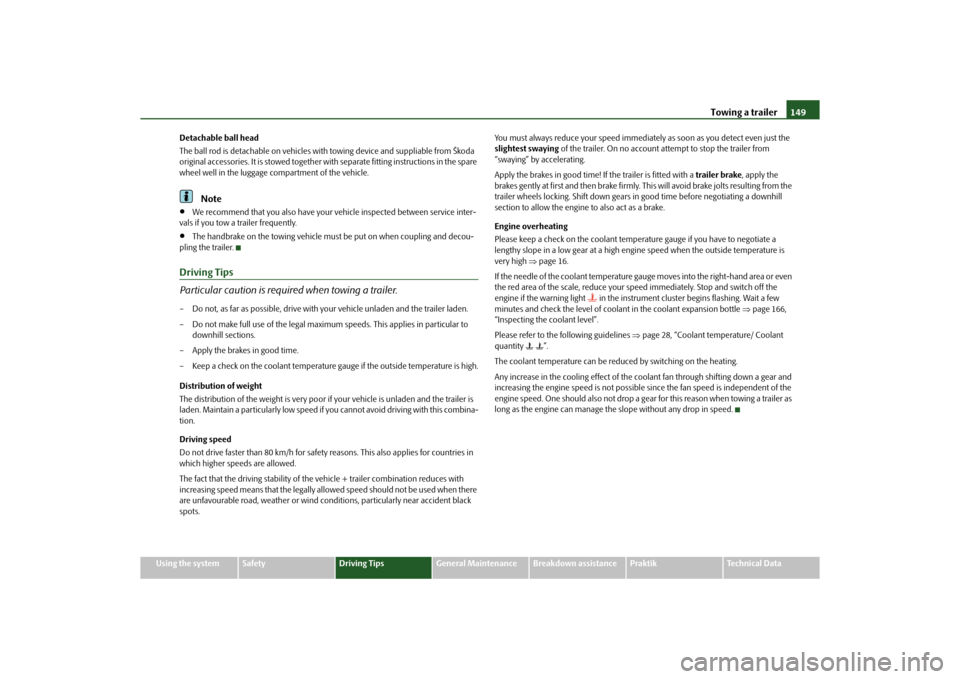
Towing a trailer149
Using the system
Safety
Driving Tips
General Maintenance
Breakdown assistance
Praktik
Technical Data
Detachable ball head
The ball rod is detachable on vehicles with towing devi
ce and suppliable from Škoda
original accessories. It is stowed together with separate fitting instructions in the spare
wheel well in the luggage compartment of the vehicle.
Note
We recommend that you also have your vehicle inspected between service inter-
vals if you tow a trailer frequently.
The handbrake on the towing vehicle must be put on when coupling and decou-
pling the trailer.
Driving Tips
Particular caution is required when towing a trailer.– Do not, as far as possible, drive with your vehicle unladen and the trailer laden.
– Do not make full use of the legal maximum speeds. This applies in particular to downhill sections.
– Apply the brakes in good time.
– Keep a check on the coolant temperature gauge if the outside temperature is high.
Distribution of weight
The distribution of the weight is very poor if your vehicle is unladen and the trailer is
laden. Maintain a particularly low speed if you cannot avoid driving with this combina-
tion.
Driving speed
Do not drive faster than 80 km/h for safety reasons. This also applies for countries in
which higher speeds are allowed.
The fact that the driving stability of the vehicle + trailer combination reduces with
increasing speed means that the legally allo wed speed should not be used when there
are unfavourable road, weather or wind cond itions, particularly near accident black
spots. You must always reduce your speed immediat
ely as soon as you detect even just the
slightest swaying of the trailer. On no account attempt to stop the trailer from
“swaying” by accelerating.
Apply the brakes in good time! If the trailer is fitted with a trailer brake, apply the
brakes gently at first and then brake firmly. This will avoid brake jolts resulting from the
trailer wheels locking. Shift down gears in good time before negotiating a downhill
section to allow the engine to also act as a brake.
Engine overheating
Please keep a check on the coolant temperature gauge if you have to negotiate a
lengthy slope in a low gear at a high engi ne speed when the outside temperature is
very high page 16.
If the needle of the coolant temperature gauge moves into the right-hand area or even
the red area of the scale, reduce your speed immediately. Stop and switch off the
engine if the warning light
in the instrument cluster begins flashing. Wait a few
minutes and check the level of coolant in the coolant expansion bottle page 166,
“Inspecting the coolant level”.
Please refer to the following guidelines page 28, “Coolant temperature/ Coolant
quantity ”.
The coolant temperature can be reduced by switching on the heating.
Any increase in the cooling effect of the coolant fan through shifting down a gear and
increasing the engine speed is not possible since the fan speed is independent of the
engine speed. One should also not drop a gear for this reason when towing a trailer as
long as the engine can manage th e slope without any drop in speed.
s16g.4.book Page 149 Wednesda y, February 10, 2010 3:53 PM
Page 164 of 231
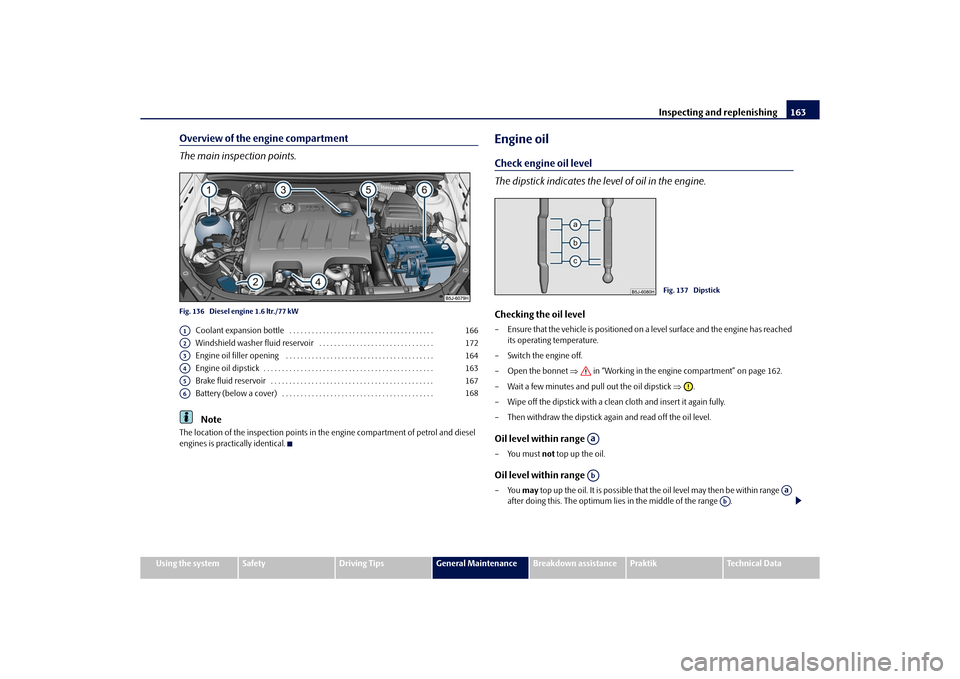
Inspecting and replenishing163
Using the system
Safety
Driving Tips
General Maintenance
Breakdown assistance
Praktik
Technical Data
Overview of the engine compartment
The main inspection points.Fig. 136 Diesel engine 1.6 ltr./77 kW
Coolant expansion bottle . . . . . . . . . . . . . . . . . . . . . . . . . . . . . . . . . . . . . . .
Windshield washer fluid reservoir . . . . . . . . . . . . . . . . . . . . . . . . . . . . . . .
Engine oil filler opening . . . . . . . . . . . . . . . . . . . . . . . . . . . . . . . . . . . . . . . .
Engine oil dipstick . . . . . . . . . . . . . . . . . . . . . . . . . . . . . . . . . . . . . . . . . . . . . .
Brake fluid reservoir . . . . . . . . . . . . . . . . . . . . . . . . . . . . . . . . . . . . . . . . . . . .
Battery (below a cover) . . . . . . . . . . . . . . . . . . . . . . . . . . . . . . . . . . . . . . . . .Note
The location of the inspection points in th e engine compartment of petrol and diesel
engines is practically identical.
Engine oilCheck engine oil level
The dipstick indicates the le vel of oil in the engine.Checking the oil level– Ensure that the vehicle is positioned on a level surface and the engine has reached
its operating temperature.
– Switch the engine off.
– Open the bonnet in “Working in the engine compartment” on page 162.
– Wait a few minutes and pull out the oil dipstick .
– Wipe off the dipstick with a clea n cloth and insert it again fully.
– Then withdraw the dipstick again and read off the oil level.Oil level within range –You must not top up the oil.Oil level within range –You may top up the oil. It is possible that the oil level may then be within range
after doing this. The optimum lies in the middle of the range .
A1
166
A2
172
A3
164
A4
163
A5
167
A6
168
Fig. 137 Dipstick
AaAb
Aa
Ab
s16g.4.book Page 163 Wednesda y, February 10, 2010 3:53 PM
Page 167 of 231
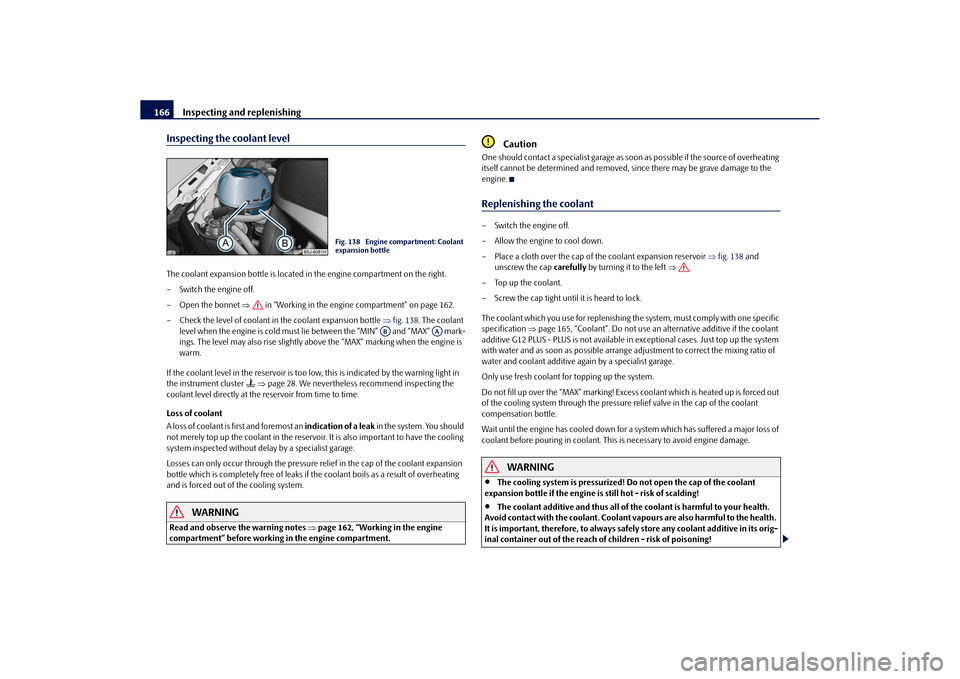
Inspecting and replenishing
166
Inspecting the coolant levelThe coolant expansion bottle is located in the engine compartment on the right.
– Switch the engine off.
– Open the bonnet in “Working in the engine compartment” on page 162.
– Check the level of coolant in the coolant expansion bottle fig. 138 . The coolant
level when the engine is cold must lie between the “MIN” and “MAX” mark-
ings. The level may also rise slightly above the “MAX” marking when the engine is
warm.
If the coolant level in the reservoir is too lo w, this is indicated by the warning light in
the instrument cluster
page 28. We nevertheless recommend inspecting the
coolant level directly at the reservoir from time to time.
Loss of coolant
A loss of coolant is first and foremost an indication of a leak in the system. You should
not merely top up the coolant in the reservoir. It is also important to have the cooling
system inspected without delay by a specialist garage.
Losses can only occur through the pressure relief in the cap of the coolant expansion
bottle which is completely free of leaks if the coolant boils as a result of overheating
and is forced out of the cooling system.
WARNING
Read and observe the warning notes page 162, “Working in the engine
compartment” before working in the engine compartment.
Caution
One should contact a specialist garage as s oon as possible if the source of overheating
itself cannot be determined and removed, since there may be grave damage to the
engine.Replenishing the coolant– Switch the engine off.
– Allow the engine to cool down.
– Place a cloth over the cap of the coolant expansion reservoir fig. 138 and
unscrew the cap carefully by turning it to the left .
–Top up the coolant.
– Screw the cap tight until it is heard to lock.
The coolant which you use for replenishing the system, must comply with one specific
specification page 165, “Coolant”. Do not use an al ternative additive if the coolant
additive G12 PLUS - PLUS is not available in exceptional cases. Just top up the system
with water and as soon as possible arrange adjustment to correct the mixing ratio of
water and coolant additive again by a specialist garage.
Only use fresh coolant for topping up the system.
Do not fill up over the “MAX” marking! Excess coolant which is heated up is forced out
of the cooling system through the pressure relief valve in the cap of the coolant
compensation bottle.
Wait until the engine has cooled down for a system which has suffered a major loss of
coolant before pouring in coolant. This is necessary to avoid engine damage.
WARNING
The cooling system is pressurized! Do not open the cap of the coolant
expansion bottle if the engine is still hot - risk of scalding!
The coolant additive and thus all of the coolant is harmful to your health.
Avoid contact with the coolant. Coolant vapours are also harmful to the health.
It is important, therefore, to always safely store any coolant additive in its orig-
inal container out of the reach of children - risk of poisoning!
Fig. 138 Engine compartment: Coolant
expansion bottle
AB
AA
s16g.4.book Page 166 Wednesda y, February 10, 2010 3:53 PM
Page 168 of 231
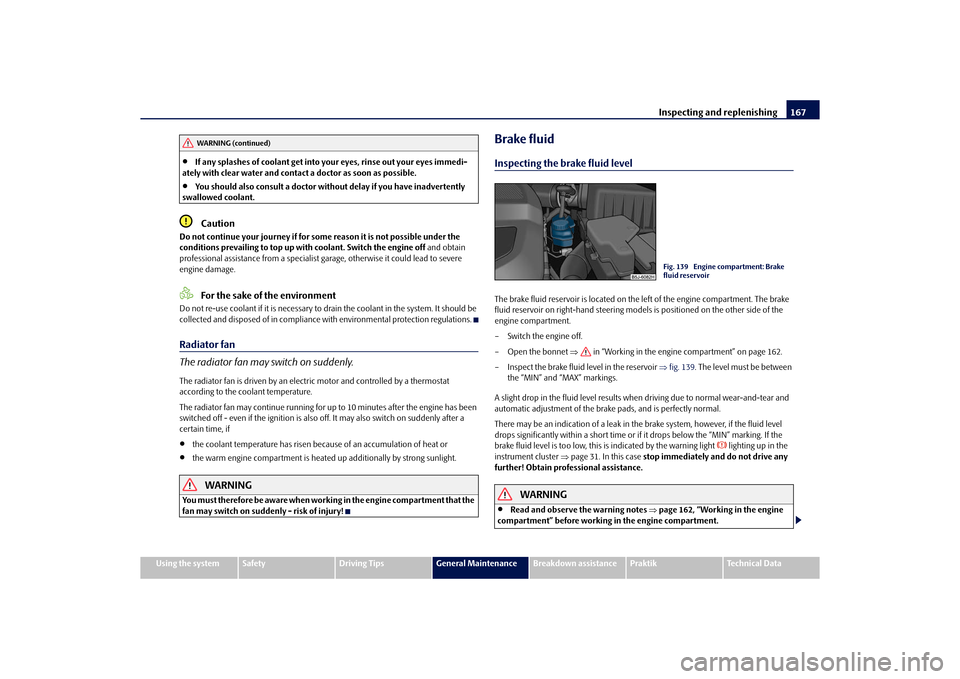
Inspecting and replenishing167
Using the system
Safety
Driving Tips
General Maintenance
Breakdown assistance
Praktik
Technical Data
If any splashes of coolant get into yo ur eyes, rinse out your eyes immedi-
ately with clear water and contact a doctor as soon as possible.
You should also consult a doctor without delay if you have inadvertently
swallowed coolant.Caution
Do not continue your journey if for some reason it is not possible under the
conditions prevailing to top up with coolant. Switch the engine off and obtain
professional assistance from a specialist garage, otherwise it could lead to severe
engine damage.
For the sake of the environment
Do not re-use coolant if it is necessary to drain the coolant in the system. It should be
collected and disposed of in compliance with environmental protection regulations.Radiator fan
The radiator fan may switch on suddenly.The radiator fan is driven by an electric motor and controlled by a thermostat
according to the coolant temperature.
The radiator fan may continue running for up to 10 minutes after the engine has been
switched off - even if the igni tion is also off. It may also switch on suddenly after a
certain time, if
the coolant temperature has risen beca use of an accumulation of heat or
the warm engine compartment is heated up additionally by strong sunlight.
WARNING
You must therefore be aware when workin g in the engine compartment that the
fan may switch on suddenly - risk of injury!
Brake fluidInspecting the brake fluid levelThe brake fluid reservoir is located on the left of the engine compartment. The brake
fluid reservoir on right-hand steering models is positioned on the other side of the
engine compartment.
– Switch the engine off.
– Open the bonnet in “Working in the engine compartment” on page 162.
– Inspect the brake fluid level in the reservoir fig. 139 . The level must be between
the “MIN” and “MAX” markings.
A slight drop in the fluid level results when driving due to normal wear-and-tear and
automatic adjustment of the brak e pads, and is perfectly normal.
There may be an indication of a leak in the brake system, however, if the fluid level
drops significantly within a short time or if it drops below the “MIN” marking. If the
brake fluid level is too low, this is indicated by the warning light
lighting up in the
instrument cluster page 31. In this case stop immediately and do not drive any
further! Obtain professional assistance.
WARNING
Read and observe the warning notes page 162, “Working in the engine
compartment” before working in the engine compartment.
WARNING (continued)
Fig. 139 Engine compartment: Brake
fluid reservoir
s16g.4.book Page 167 Wednesda y, February 10, 2010 3:53 PM
Page 223 of 231
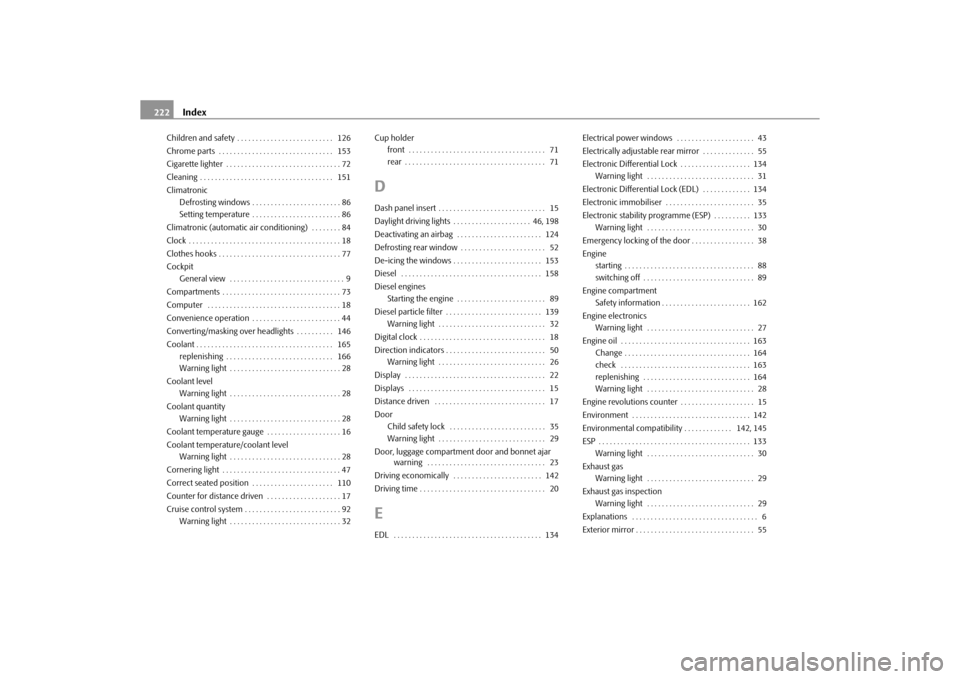
Index
222
Children and safety . . . . . . . . . . . . . . . . . . . . . . . . . . 126
Chrome parts . . . . . . . . . . . . . . . . . . . . . . . . . . . . . . . 153
Cigarette lighter . . . . . . . . . . . . . . . . . . . . . . . . . . . . . . . 72
Cleaning . . . . . . . . . . . . . . . . . . . . . . . . . . . . . . . . . . . . 151
Climatronic
Defrosting windows . . . . . . . . . . . . . . . . . . . . . . . . 86
Setting temperature . . . . . . . . . . . . . . . . . . . . . . . . 86
Climatronic (automat ic air conditioning) . . . . . . . . 84
Clock . . . . . . . . . . . . . . . . . . . . . . . . . . . . . . . . . . . . . . . . . 18
Clothes hooks . . . . . . . . . . . . . . . . . . . . . . . . . . . . . . . . . 77
Cockpit General view . . . . . . . . . . . . . . . . . . . . . . . . . . . . . . . 9
Compartments . . . . . . . . . . . . . . . . . . . . . . . . . . . . . . . . 73
Computer . . . . . . . . . . . . . . . . . . . . . . . . . . . . . . . . . . . . 18
Convenience operation . . . . . . . . . . . . . . . . . . . . . . . . 44
Converting/masking over headlights . . . . . . . . . . 146
Coolant . . . . . . . . . . . . . . . . . . . . . . . . . . . . . . . . . . . . . 165 replenishing . . . . . . . . . . . . . . . . . . . . . . . . . . . . . 166
Warning light . . . . . . . . . . . . . . . . . . . . . . . . . . . . . . 28
Coolant level Warning light . . . . . . . . . . . . . . . . . . . . . . . . . . . . . . 28
Coolant quantity Warning light . . . . . . . . . . . . . . . . . . . . . . . . . . . . . . 28
Coolant temperature gauge . . . . . . . . . . . . . . . . . . . . 16
Coolant temperature/coolant level Warning light . . . . . . . . . . . . . . . . . . . . . . . . . . . . . . 28
Cornering light . . . . . . . . . . . . . . . . . . . . . . . . . . . . . . . . 47
Correct seated position . . . . . . . . . . . . . . . . . . . . . . 110
Counter for distance driven . . . . . . . . . . . . . . . . . . . . 17
Cruise control system . . . . . . . . . . . . . . . . . . . . . . . . . . 92 Warning light . . . . . . . . . . . . . . . . . . . . . . . . . . . . . . 32 Cup holder
front . . . . . . . . . . . . . . . . . . . . . . . . . . . . . . . . . . . . . 71
rear . . . . . . . . . . . . . . . . . . . . . . . . . . . . . . . . . . . . . . 71
DDash panel insert . . . . . . . . . . . . . . . . . . . . . . . . . . . . . 15
Daylight driving lights . . . . . . . . . . . . . . . . . . . . . 46, 198
Deactivating an airbag . . . . . . . . . . . . . . . . . . . . . . . 124
Defrosting rear window . . . . . . . . . . . . . . . . . . . . . . . 52
De-icing the windows . . . . . . . . . . . . . . . . . . . . . . . . 153
Diesel . . . . . . . . . . . . . . . . . . . . . . . . . . . . . . . . . . . . . . 158
Diesel enginesStarting the engine . . . . . . . . . . . . . . . . . . . . . . . . 89
Diesel particle filter . . . . . . . . . . . . . . . . . . . . . . . . . . 139 Warning light . . . . . . . . . . . . . . . . . . . . . . . . . . . . . 32
Digital clock . . . . . . . . . . . . . . . . . . . . . . . . . . . . . . . . . . 18
Direction indicators . . . . . . . . . . . . . . . . . . . . . . . . . . . 50 Warning light . . . . . . . . . . . . . . . . . . . . . . . . . . . . . 26
Display . . . . . . . . . . . . . . . . . . . . . . . . . . . . . . . . . . . . . . 22
Displays . . . . . . . . . . . . . . . . . . . . . . . . . . . . . . . . . . . . . 15
Distance driven . . . . . . . . . . . . . . . . . . . . . . . . . . . . . . 17
Door Child safety lock . . . . . . . . . . . . . . . . . . . . . . . . . . 35
Warning light . . . . . . . . . . . . . . . . . . . . . . . . . . . . . 29
Door, luggage compartment door and bonnet ajar warning . . . . . . . . . . . . . . . . . . . . . . . . . . . . . . . . 23
Driving economically . . . . . . . . . . . . . . . . . . . . . . . . 142
Driving time . . . . . . . . . . . . . . . . . . . . . . . . . . . . . . . . . . 20EEDL . . . . . . . . . . . . . . . . . . . . . . . . . . . . . . . . . . . . . . . . 134 Electrical power windows . . . . . . . . . . . . . . . . . . . . . 43
Electrically adjustable rear mirror . . . . . . . . . . . . . . 55
Electronic Differential Lock . . . . . . . . . . . . . . . . . . . 134
Warning light . . . . . . . . . . . . . . . . . . . . . . . . . . . . . 31
Electronic Differential Lock (EDL) . . . . . . . . . . . . . 134
Electronic immobiliser . . . . . . . . . . . . . . . . . . . . . . . . 35
Electronic stability programme (ESP) . . . . . . . . . . 133 Warning light . . . . . . . . . . . . . . . . . . . . . . . . . . . . . 30
Emergency locking of the door . . . . . . . . . . . . . . . . . 38
Engine starting . . . . . . . . . . . . . . . . . . . . . . . . . . . . . . . . . . . 88
switching off . . . . . . . . . . . . . . . . . . . . . . . . . . . . . . 89
Engine compartment Safety information . . . . . . . . . . . . . . . . . . . . . . . . 162
Engine electronics Warning light . . . . . . . . . . . . . . . . . . . . . . . . . . . . . 27
Engine oil . . . . . . . . . . . . . . . . . . . . . . . . . . . . . . . . . . . 163 Change . . . . . . . . . . . . . . . . . . . . . . . . . . . . . . . . . . 164
check . . . . . . . . . . . . . . . . . . . . . . . . . . . . . . . . . . . 163
replenishing . . . . . . . . . . . . . . . . . . . . . . . . . . . . . 164
Warning light . . . . . . . . . . . . . . . . . . . . . . . . . . . . . 28
Engine revolutions counter . . . . . . . . . . . . . . . . . . . . 15
Environment . . . . . . . . . . . . . . . . . . . . . . . . . . . . . . . . 142
Environmental compatibility . . . . . . . . . . . . . 142, 145
ESP . . . . . . . . . . . . . . . . . . . . . . . . . . . . . . . . . . . . . . . . . 133 Warning light . . . . . . . . . . . . . . . . . . . . . . . . . . . . . 30
Exhaust gas Warning light . . . . . . . . . . . . . . . . . . . . . . . . . . . . . 29
Exhaust gas inspection Warning light . . . . . . . . . . . . . . . . . . . . . . . . . . . . . 29
Explanations . . . . . . . . . . . . . . . . . . . . . . . . . . . . . . . . . . 6
Exterior mirror . . . . . . . . . . . . . . . . . . . . . . . . . . . . . . . . 55
s16g.4.book Page 222 Wednesda y, February 10, 2010 3:53 PM